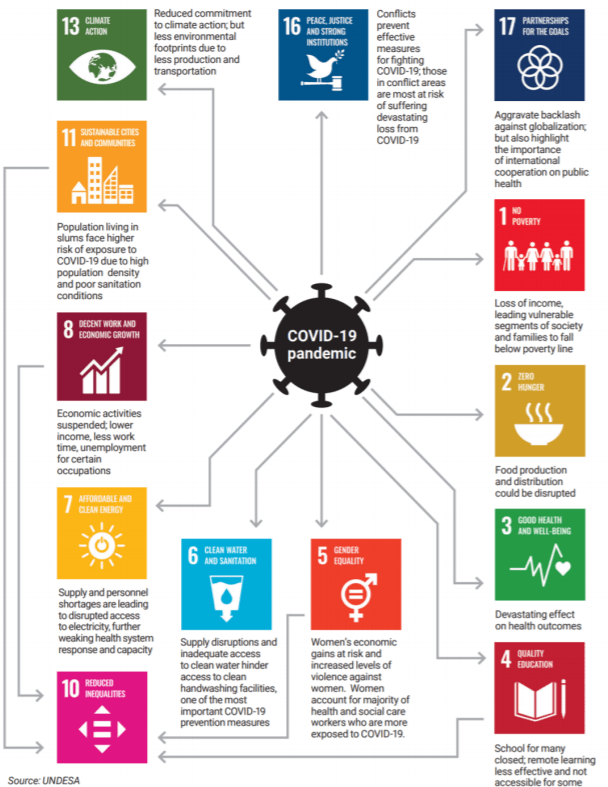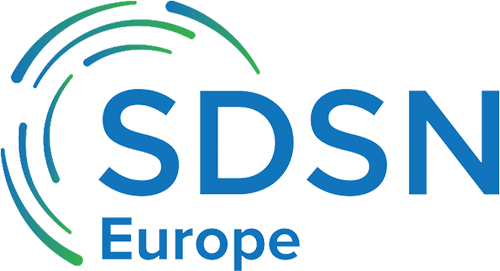The Europe Sustainable Development Report (ESDR) webinar took place on 29 April as part of SDSN’s webinar series, Tracking National Progress. The webinar covered highlights from the ESDR released in November and how COVID-19 has impacted the findings from the report. The report was written in partnership with the Sustainable Development Solutions Network (SDSN) and the Institute for European Environmental Policy (IEEP).
COVID-19 and SDGs
SDG Index Manager Guillaume LaFortune kicked off the webinar and asked the audience how they think COVID-19 will affect the progress of the SDGs, and the results were mixed. Some of the audience thought COVID-19 would accelerate and therefore slow down the progress of the SDGs, while others thought it would solely slow down the progress of the SDGs regardless of the virus accelerating or not. These results show that the European Union (EU) still has to come to reach a collective effort if it wants to achieve the SDGs by 2030.
Below is a graphic on how COVID-19 has impacted each SDG.

ESDR Results
The results from the ESDR can also be discovered via SDSN’s in-depth Interactive SDGs Dashboard. The interactive dashboard allows one to compare different countries within the EU to one another and also see how each country is performing on every SDG. Lafortune explained that the average SDG index score of the EU was 70 (meaning a country is 70% of the way to achieving the SDGs). While this score is higher than in many other regions, the results within each SDG were mixed.
Results revealed:
- All countries need to see improvement in SDG 2 (Zero Hunger).
- Countries were inconsistent in achieving SDG 9 (Industry, Innovation, and Infrastructure) and SDG 10 (Reducing Inequality).
- Collectively, all countries performed poorly in SDGs 12 – 15.
The overall poor performance on SDGs 12 – 15 highlights how biodiversity is rapidly declining, temperatures are rising, and how not enough changes are being made to not only meet the SDGs, but also to protect the Earth.
EU Approach to Achieving the SDGs and Remaining Resilient Post-COVID-19
The IEEP suggests that the European Green Deal can help to align the SDGs so that countries are held more accountable for their actions on progressing the SDGs. Tsvetelina Filipova of IEEP explained in the webinar that the European Green Deal was created by the European Commission to implement and to meet the goals of Agenda 2030. Filopova stated that the European Green Deal will:
- Regularly assess progress toward achieving the SDGs and creating target goals for each country to meet
- Align the EU’s strategies regarding sustainable development to the SDGs
- Implement measures to “ensure a fair transition and strengthen the EU’s resilience and preparedness for major disruptive events.”
The European Commission also created the European Semester, a strategic plan to help countries maintain economic goals and budgets, including in the midst of a global pandemic. Eloise Bodin of IEEP stated that aligning the European Semester and the European Green Deal to the SDGs is key to the short and long-term recovery plan of the EU.
Countries still need to progress on the SDGs, even in a global pandemic. It is up to the citizens of the EU and global citizens everywhere to achieve this goal.
We were unable to answer all questions during the short hour of the webinar. Below you will find the questions that we were unable to get to and their answers:
Can you explain the possible cause of disparity in SDG 9 a little more?
The EU is a global leader in education and technology, but innovation is very uneven across its regions. Figure 10 in the report shows for instance the gap in patent applications between Northern Europe and Central and Eastern Europe & Baltic States. Regions that lag behind in innovation also lag behind in good jobs, investment, and long-term growth potential. We argue that an EU strategy to achieve the SDGs should build on quality education across the Union, the active engagement of girls in Science, Technology, Engineering and Mathematics (STEM) education and professional training, and the promotion of new technology missions to put the EU in the leadership of sustainable technologies (Mazzucato, 2018).
Which levers the EU could use to improve SDG 12 (responsible consumption and production)?
The report explored the role of the European Green Deal as well as other strategies and policies including the EU circular economy action plan and revised Common Agricultural Policy. We also discussed the role of budget and macroeconomic coordination via the Multi Annual Financial Framework (MFF) 2021-2027 and the European Semester. We also discussed the role of research programmes and new Horizon Europe and monitoring systems.
When can we expect to have a LNOB (Leave No One Behind) index that applies to all countries?
The LNOB Index uses extensively “gap” indicators which look at the gap in outcome (life expectancy, unmet care needs, education outcomes, safety etc.) across population groups (by income, urban vs rural, gender, etc.). For now, OECD countries and EU countries have the most advanced statistical infrastructure in place to track internationally outcome data disaggregated by population groups. We use for instance data coming from the OECD Pisa (education) and the EU-SILC (health). We are exploring ways to leverage other regional data sources in Africa and other regions to replicate our LNOB Index to other regions.
How do interlinkages between different SDGs show up in the results?
The aim of this report is to track performance on each 17 SDGs. In the opening sections we discuss the need for Six Transformations which, in our view, can be achieved without offsetting performance on another Transformation. The issue of trade-offs and synergies across SDGs is quite well documented (International Council for Science, 2017; Nilsson et al., 2016a; Reyers et al., 2017; Kroll et al, 2019; Miola et al, 2019b; OECD, 2019).
Are EU territories outside of the European borders (example EU countries with islands in the Pacific or Atlantic, or South America such as French Guiana) taken into account?
It varies across indicators and data sources. For official statistics, we use primarily data that come from the OECD and the European Commission which collect data from National Statistical Offices (NSOs). Depending on what NSOs submit to international organizations data include or exclude overseas territories. For many indicators, Eurostat presents data for outermost regions as a separate line. Some data are available specifically for outermost regions at territorial level 3 (Nuts3).
Better regulation is very much designed for the EU policy and regulatory processes, but there are great tools that can be adapted to national conditions. It is worth checking the Better regulation guidelines and the tools in the toolbox here.
What is the timeline for developing and implementing SDG coherent regulation given there are 10 years left to achieve the SDGs? Are there specific efforts already underway you can point to?There is not clear timeframe, the SDG mainstreaming in Better regulation is part of ongoing process of integrating SDG in EU policies. By the end of May Commission Communication on this is expected to be published which will provide further clarity.
The EU GND is a wonderful feat and show of leadership for the world. How will COVID impact its implementation given this year many work streams were meant to be under way now?
Indeed there are delays of the original Commission programme for development of some of the strategies and plans provisioned by the Green deal understandably. However it is great that Commission is committed to a sustainable and green recovery plan post Covid19, and pledge funds for relevant measures as recently reaffirmed by Commissioner von der Leyen.




